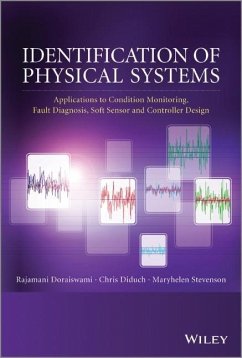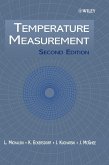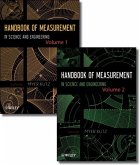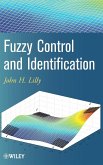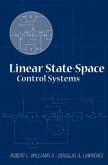Identification of Physical Systems
Applications to Condition Monitoring, Fault Diagnosis, Soft Sensor and Controller Design
Identification of Physical Systems
Applications to Condition Monitoring, Fault Diagnosis, Soft Sensor and Controller Design
- Gebundenes Buch
- Merkliste
- Auf die Merkliste
- Bewerten Bewerten
- Teilen
- Produkt teilen
- Produkterinnerung
- Produkterinnerung
Identification of a physical system deals with the problem ofidentifying its mathematical model using the measured input andoutput data. As the physical system is generally complex,nonlinear, and its input-output data is corrupted noise,there are fundamental theoretical and practical issues that need tobe considered.
Identification of Physical Systems addresses this need,presenting a systematic, unified approach to the problem ofphysical system identification and its practicalapplications. Starting with a least-squares method, theauthors develop various schemes to address the issues of…mehr
![Temperature Measurement Temperature Measurement]() Ludwig MichalskiTemperature Measurement473,99 €
Ludwig MichalskiTemperature Measurement473,99 €![Handbook of Measurement in Science and Engineering, 2 Volume Set Handbook of Measurement in Science and Engineering, 2 Volume Set]() Myer KutzHandbook of Measurement in Science and Engineering, 2 Volume Set749,99 €
Myer KutzHandbook of Measurement in Science and Engineering, 2 Volume Set749,99 €![Fuzzy Control and Identification Fuzzy Control and Identification]() John H. LillyFuzzy Control and Identification138,99 €
John H. LillyFuzzy Control and Identification138,99 €![Linear State-Space Control Systems Linear State-Space Control Systems]() Robert L. WilliamsLinear State-Space Control Systems165,99 €
Robert L. WilliamsLinear State-Space Control Systems165,99 €![Fundamentals of Optical Fiber Sensors Fundamentals of Optical Fiber Sensors]() Zujie FangFundamentals of Optical Fiber Sensors138,99 €
Zujie FangFundamentals of Optical Fiber Sensors138,99 €![Predictive Control of Power Converters and Electrical Drives Predictive Control of Power Converters and Electrical Drives]() José RodriguezPredictive Control of Power Converters and Electrical Drives157,99 €
José RodriguezPredictive Control of Power Converters and Electrical Drives157,99 €![System of Systems Engineering System of Systems Engineering]() System of Systems Engineering183,99 €
System of Systems Engineering183,99 €-
-
-
Identification of Physical Systems addresses this need,presenting a systematic, unified approach to the problem ofphysical system identification and its practicalapplications. Starting with a least-squares method, theauthors develop various schemes to address the issues of accuracy,variation in the operating regimes, closed loop, and interconnectedsubsystems. Also presented is a non-parametric signal or data-basedscheme to identify a means to provide a quick macroscopic pictureof the system to complement the precise microscopic picture givenby the parametric model-based scheme. Finally, a sequentialintegration of totally different schemes, such as non-parametric,Kalman filter, and parametric model, is developed to meet the speedand accuracy requirement of mission-critical systems.
Key features:
Provides a clear understanding of theoretical and practicalissues in identification and its applications, enabling the readerto grasp a clear understanding of the theory and apply it topractical problems
Offers a self-contained guide by including the backgroundnecessary to understand this interdisciplinary subject
Includes case studies for the application of identification onphysical laboratory scale systems, as well as number ofillustrative examples throughout the book
Identification of Physical Systems is a comprehensivereference for researchers and practitioners working in this fieldand is also a useful source of information for graduate students inelectrical, computer, biomedical, chemical, and mechanicalengineering.
- Produktdetails
- Verlag: Wiley & Sons
- 1. Auflage
- Seitenzahl: 536
- Erscheinungstermin: 12. Mai 2014
- Englisch
- Abmessung: 251mm x 172mm x 32mm
- Gewicht: 947g
- ISBN-13: 9781119990123
- ISBN-10: 1119990122
- Artikelnr.: 38475248
- Verlag: Wiley & Sons
- 1. Auflage
- Seitenzahl: 536
- Erscheinungstermin: 12. Mai 2014
- Englisch
- Abmessung: 251mm x 172mm x 32mm
- Gewicht: 947g
- ISBN-13: 9781119990123
- ISBN-10: 1119990122
- Artikelnr.: 38475248
Nomenclature xxi
1 Modeling of Signals and Systems 1
1.1 Introduction 1
1.2 Classification of Signals 2
1.3 Model of Systems and Signals 5
1.4 Equivalence of Input-Output and State-Space Models 8
1.5 Deterministic Signals 11
1.6 Introduction to Random Signals 23
1.7 Model of Random Signals 28
1.8 Model of a System with Disturbance and Measurement Noise 41
1.9 Summary 50
References 54
Further Readings 54
2 Characterization of Signals: Correlation and Spectral Density 57
2.1 Introduction 57
2.2 Definitions of Auto- and Cross-Correlation (and Covariance) 58
2.3 Spectral Density: Correlation in the Frequency Domain 67
2.4 Coherence Spectrum 74
2.5 Illustrative Examples in Correlation and Spectral Density 76
2.6 Input-Output Correlation and Spectral Density 91
2.7 Illustrative Examples: Modeling and Identification 98
2.8 Summary 109
2.9 Appendix 112
References 116
3 Estimation Theory 117
3.1 Overview 117
3.2 Map Relating Measurement and the Parameter 119
3.3 Properties of Estimators 123
3.4 Cramér-Rao Inequality 127
3.5 Maximum Likelihood Estimation 139
3.6 Summary 154
3.7 Appendix: Cauchy-Schwarz Inequality 157
3.8 Appendix: Cram´er-Rao Lower Bound 157
3.9 Appendix: Fisher Information: Cauchy PDF 161
3.10 Appendix: Fisher Information for i.i.d. PDF 161
3.11 Appendix: Projection Operator 162
3.12 Appendix: Fisher Information: Part Gauss-Part Laplace 164
Problem 165
References 165
Further Readings 165
4 Estimation of Random Parameter 167
4.1 Overview 167
4.2 Minimum Mean-Squares Estimator (MMSE): Scalar Case 167
4.3 MMSE Estimator: Vector Case 169
4.4 Expression for Conditional Mean 172
4.5 Summary 183
4.6 Appendix: Non-Gaussian Measurement PDF 184
References 188
Further Readings 188
5 Linear Least-Squares Estimation 189
5.1 Overview 189
5.2 Linear Least-Squares Approach 189
5.3 Performance of the Least-Squares Estimator 195
5.4 Illustrative Examples 205
5.5 Cram´er-Rao Lower Bound 209
5.6 Maximum Likelihood Estimation 210
5.7 Least-Squares Solution of Under-Determined System 212
5.8 Singular Value Decomposition 213
5.9 Summary 218
5.10 Appendix: Properties of the Pseudo-Inverse and the Projection Operator 221
5.11 Appendix: Positive Definite Matrices 222
5.12 Appendix: Singular Value Decomposition of a Matrix 223
5.13 Appendix: Least-Squares Solution for Under-Determined System 228
5.14 Appendix: Computation of Least-Squares Estimate Using the SVD 229
References 229
Further Readings 230
6 Kalman Filter 231
6.1 Overview 231
6.2 Mathematical Model of the System 233
6.3 Internal Model Principle 236
6.4 Duality Between Controller and an Estimator Design 244
6.5 Observer: Estimator for the States of a System 246
6.6 Kalman Filter: Estimator of the States of a Stochastic System 250
6.7 The Residual of the Kalman Filter with Model Mismatch and Non-Optimal Gain 267
6.8 Summary 274
6.9 Appendix: Estimation Error Covariance and the Kalman Gain 277
6.10 Appendix: The Role of the Ratio of Plant and the Measurement Noise Variances 279
6.11 Appendix: Orthogonal Properties of the Kalman Filter 279
6.12 Appendix: Kalman Filter Residual with Model Mismatch 285
References 287
7 System Identification 289
7.1 Overview 289
7.2 System Model 291
7.3 Kalman Filter-Based Identification Model Structure 297
7.4 Least-Squares Method 307
7.5 High-Order Least-Squares Method 318
7.6 The Prediction Error Method 327
7.7 Comparison of High-Order Least-Squares and the Prediction Error Methods 330
7.8 Subspace Identification Method 334
7.9 Summary 340
7.10 Appendix: Performance of the Least-Squares Approach 347
7.11 Appendix: Frequency-Weighted Model Order Reduction 352
References 354
8 Closed Loop Identification 357
8.1 Overview 357
8.2 Closed-Loop System 359
8.3 Model of the Single Input Multi-Output System 360
8.4 Kalman Filter-Based Identification Model 364
8.5 Closed-Loop Identification Schemes 366
8.6 Second Stage of the Two-Stage Identification 372
8.7 Evaluation on a Simulated Closed-Loop Sensor Net 372
8.8 Summary 374
References 377
9 Fault Diagnosis 379
9.1 Overview 379
9.2 Mathematical Model of the System 381
9.3 Model of the Kalman Filter 382
9.4 Modeling of Faults 383
9.5 Diagnostic Parameters and the Feature Vector 384
9.6 Illustrative Example 386
9.7 Residual of the Kalman Filter 388
9.8 Fault Diagnosis 390
9.9 Fault Detection: Bayes Decision Strategy 390
9.10 Evaluation of Detection Strategy on Simulated System 396
9.11 Formulation of Fault Isolation Problem 396
9.12 Estimation of the Influence Vectors and Additive Fault 399
9.13 Fault Isolation Scheme 401
9.14 Isolation of a Single Fault 403
9.15 Emulators for Offline Identification 406
9.16 Illustrative Example 409
9.17 Overview of Fault Diagnosis Scheme 414
9.18 Evaluation on a Simulated Example 414
9.19 Summary 418
9.20 Appendix: Bayesian Multiple Composite Hypotheses Testing Problem 422
9.21 Appendix: Discriminant Function for Fault Isolation 423
9.22 Appendix: Log-Likelihood Ratio for a Sinusoid and a Constant 424
References 426
10 Modeling and Identification of Physical Systems 427
10.1 Overview 427
10.2 Magnetic Levitation System 427
10.3 Two-Tank Process Control System 436
10.4 Position Control System 442
10.5 Summary 444
References 446
11 Fault Diagnosis of Physical Systems 447
11.1 Overview 447
11.2 Two-Tank Physical Process Control System 448
11.3 Position Control System 452
11.4 Summary 457
References 457
12 Fault Diagnosis of a Sensor Network 459
12.1 Overview 459
12.2 Problem Formulation 461
12.3 Fault Diagnosis Using a Bank of Kalman Filters 461
12.4 Kalman Filter for Pairs of Measurements 462
12.5 Kalman Filter for the Reference Input-Measurement Pair 463
12.6 Kalman Filter Residual: A Model Mismatch Indicator 463
12.7 Bayes Decision Strategy 464
12.8 Truth Table of Binary Decisions 465
12.9 Illustrative Example 467
12.10 Evaluation on a Physical Process Control System 469
12.11 Fault Detection and Isolation 470
12.12 Summary 474
12.13 Appendix 475
References 477
13 Soft Sensor 479
13.1 Review 479
13.2 Mathematical Formulation 481
13.3 Identification of the System 483
13.4 Model of the Kalman Filter 488
13.5 Robust Controller Design 489
13.6 High Performance and Fault Tolerant Control System 494
13.7 Evaluation on a Simulated System: Soft Sensor 496
13.8 Evaluation on a Physical Velocity Control System 500
13.9 Conclusions 502
13.10 Summary 503
References 507
Index 509
Nomenclature xxi
1 Modeling of Signals and Systems 1
1.1 Introduction 1
1.2 Classification of Signals 2
1.3 Model of Systems and Signals 5
1.4 Equivalence of Input-Output and State-Space Models 8
1.5 Deterministic Signals 11
1.6 Introduction to Random Signals 23
1.7 Model of Random Signals 28
1.8 Model of a System with Disturbance and Measurement Noise 41
1.9 Summary 50
References 54
Further Readings 54
2 Characterization of Signals: Correlation and Spectral Density 57
2.1 Introduction 57
2.2 Definitions of Auto- and Cross-Correlation (and Covariance) 58
2.3 Spectral Density: Correlation in the Frequency Domain 67
2.4 Coherence Spectrum 74
2.5 Illustrative Examples in Correlation and Spectral Density 76
2.6 Input-Output Correlation and Spectral Density 91
2.7 Illustrative Examples: Modeling and Identification 98
2.8 Summary 109
2.9 Appendix 112
References 116
3 Estimation Theory 117
3.1 Overview 117
3.2 Map Relating Measurement and the Parameter 119
3.3 Properties of Estimators 123
3.4 Cramér-Rao Inequality 127
3.5 Maximum Likelihood Estimation 139
3.6 Summary 154
3.7 Appendix: Cauchy-Schwarz Inequality 157
3.8 Appendix: Cram´er-Rao Lower Bound 157
3.9 Appendix: Fisher Information: Cauchy PDF 161
3.10 Appendix: Fisher Information for i.i.d. PDF 161
3.11 Appendix: Projection Operator 162
3.12 Appendix: Fisher Information: Part Gauss-Part Laplace 164
Problem 165
References 165
Further Readings 165
4 Estimation of Random Parameter 167
4.1 Overview 167
4.2 Minimum Mean-Squares Estimator (MMSE): Scalar Case 167
4.3 MMSE Estimator: Vector Case 169
4.4 Expression for Conditional Mean 172
4.5 Summary 183
4.6 Appendix: Non-Gaussian Measurement PDF 184
References 188
Further Readings 188
5 Linear Least-Squares Estimation 189
5.1 Overview 189
5.2 Linear Least-Squares Approach 189
5.3 Performance of the Least-Squares Estimator 195
5.4 Illustrative Examples 205
5.5 Cram´er-Rao Lower Bound 209
5.6 Maximum Likelihood Estimation 210
5.7 Least-Squares Solution of Under-Determined System 212
5.8 Singular Value Decomposition 213
5.9 Summary 218
5.10 Appendix: Properties of the Pseudo-Inverse and the Projection Operator 221
5.11 Appendix: Positive Definite Matrices 222
5.12 Appendix: Singular Value Decomposition of a Matrix 223
5.13 Appendix: Least-Squares Solution for Under-Determined System 228
5.14 Appendix: Computation of Least-Squares Estimate Using the SVD 229
References 229
Further Readings 230
6 Kalman Filter 231
6.1 Overview 231
6.2 Mathematical Model of the System 233
6.3 Internal Model Principle 236
6.4 Duality Between Controller and an Estimator Design 244
6.5 Observer: Estimator for the States of a System 246
6.6 Kalman Filter: Estimator of the States of a Stochastic System 250
6.7 The Residual of the Kalman Filter with Model Mismatch and Non-Optimal Gain 267
6.8 Summary 274
6.9 Appendix: Estimation Error Covariance and the Kalman Gain 277
6.10 Appendix: The Role of the Ratio of Plant and the Measurement Noise Variances 279
6.11 Appendix: Orthogonal Properties of the Kalman Filter 279
6.12 Appendix: Kalman Filter Residual with Model Mismatch 285
References 287
7 System Identification 289
7.1 Overview 289
7.2 System Model 291
7.3 Kalman Filter-Based Identification Model Structure 297
7.4 Least-Squares Method 307
7.5 High-Order Least-Squares Method 318
7.6 The Prediction Error Method 327
7.7 Comparison of High-Order Least-Squares and the Prediction Error Methods 330
7.8 Subspace Identification Method 334
7.9 Summary 340
7.10 Appendix: Performance of the Least-Squares Approach 347
7.11 Appendix: Frequency-Weighted Model Order Reduction 352
References 354
8 Closed Loop Identification 357
8.1 Overview 357
8.2 Closed-Loop System 359
8.3 Model of the Single Input Multi-Output System 360
8.4 Kalman Filter-Based Identification Model 364
8.5 Closed-Loop Identification Schemes 366
8.6 Second Stage of the Two-Stage Identification 372
8.7 Evaluation on a Simulated Closed-Loop Sensor Net 372
8.8 Summary 374
References 377
9 Fault Diagnosis 379
9.1 Overview 379
9.2 Mathematical Model of the System 381
9.3 Model of the Kalman Filter 382
9.4 Modeling of Faults 383
9.5 Diagnostic Parameters and the Feature Vector 384
9.6 Illustrative Example 386
9.7 Residual of the Kalman Filter 388
9.8 Fault Diagnosis 390
9.9 Fault Detection: Bayes Decision Strategy 390
9.10 Evaluation of Detection Strategy on Simulated System 396
9.11 Formulation of Fault Isolation Problem 396
9.12 Estimation of the Influence Vectors and Additive Fault 399
9.13 Fault Isolation Scheme 401
9.14 Isolation of a Single Fault 403
9.15 Emulators for Offline Identification 406
9.16 Illustrative Example 409
9.17 Overview of Fault Diagnosis Scheme 414
9.18 Evaluation on a Simulated Example 414
9.19 Summary 418
9.20 Appendix: Bayesian Multiple Composite Hypotheses Testing Problem 422
9.21 Appendix: Discriminant Function for Fault Isolation 423
9.22 Appendix: Log-Likelihood Ratio for a Sinusoid and a Constant 424
References 426
10 Modeling and Identification of Physical Systems 427
10.1 Overview 427
10.2 Magnetic Levitation System 427
10.3 Two-Tank Process Control System 436
10.4 Position Control System 442
10.5 Summary 444
References 446
11 Fault Diagnosis of Physical Systems 447
11.1 Overview 447
11.2 Two-Tank Physical Process Control System 448
11.3 Position Control System 452
11.4 Summary 457
References 457
12 Fault Diagnosis of a Sensor Network 459
12.1 Overview 459
12.2 Problem Formulation 461
12.3 Fault Diagnosis Using a Bank of Kalman Filters 461
12.4 Kalman Filter for Pairs of Measurements 462
12.5 Kalman Filter for the Reference Input-Measurement Pair 463
12.6 Kalman Filter Residual: A Model Mismatch Indicator 463
12.7 Bayes Decision Strategy 464
12.8 Truth Table of Binary Decisions 465
12.9 Illustrative Example 467
12.10 Evaluation on a Physical Process Control System 469
12.11 Fault Detection and Isolation 470
12.12 Summary 474
12.13 Appendix 475
References 477
13 Soft Sensor 479
13.1 Review 479
13.2 Mathematical Formulation 481
13.3 Identification of the System 483
13.4 Model of the Kalman Filter 488
13.5 Robust Controller Design 489
13.6 High Performance and Fault Tolerant Control System 494
13.7 Evaluation on a Simulated System: Soft Sensor 496
13.8 Evaluation on a Physical Velocity Control System 500
13.9 Conclusions 502
13.10 Summary 503
References 507
Index 509

